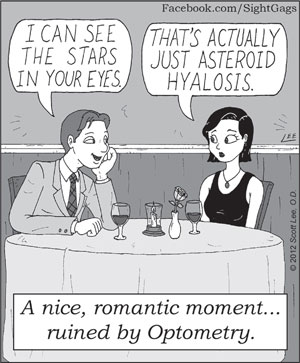In the article, “Successful Comanagement of Ocular Surgery Patients” (December 2014), Paul Karpecki, OD, appropriately urges his colleagues to be active participants in the patient’s surgical journey. Yet, he then states: “our influence goes much further than anyone else’s and has more of an impact in the patient’s success than the surgery center or the surgeon.”
Really? Surely Dr. Karpecki cannot believe, and teach others to believe, that the surgical referrer is a more powerful determinant of cataract surgery outcome than the surgeon!
Regarding ocular surgery, I would like to request a different mindset from current optometric academia; namely, that surgery is not just another tool to be delegated or ordered, as if all the nuances and demands of a surgical experience were the equivalent of having an associate or a tech do an IOP check.
After 40+ years seeing patients, I believe—even though at times it won’t seem trendy nor good business—that patient advocacy is a successful decision-making common denominator that creates unity of purpose among the professions. Also, we should say “thank you” no less than three times a day.
—J.R. McCue, MD, Bastrop, La.
Dr. Karpecki responds:
First, thank you for taking the time to share your perspective. While I have worked in ophthalmology practices my entire career, I am an optometrist who sees referrals from optometric colleagues daily.
|
Sight Gags
by Scott Lee, OD
|
| |
 |
|
|
The phrase you cite is a little out of context, but the concept is simply this: In cases where I see a patient referred to our clinic for cataract surgery, the optometrist who has seen this patient for the last 20 to 30 years holds more influence than I (the optometrist at the secondary care center) or even the surgeon does over that patient’s decisions about cataract surgery. That’s simply because the referring doctor has been trusted more in the last two to three decades than a patient will trust me during my 10- to 15-minute portion of the examination at the secondary/tertiary-care center or surgery center.
For example, if I bring up the subject of a premium IOL to a patient who has never heard of the concept, and then I mention the premium charge, one thing goes through the patient’s mind: “If it’s such a good option, why didn’t my eye doctor mention it?” In my experience, fewer than half of these patients will proceed with a premium IOL.
But when a referring or comanaging optometrist first mentions that premium IOL options will be discussed at the surgical center and the patient seems like a good candidate, it tends to be an easy conversion. In this case, nearly 90% opt for the premium IOL option. Keep in mind that in both cases, the premium IOL is in the patient’s best interest. It was the influence of the referring/comanaging optometrist that made the difference and truthfully trumped anything that either the surgeon or I could have said.
Thus, it’s incumbent upon all of us to stay educated about the latest cataract surgery technologies and IOLs, and to discuss them with patients so they can be guided to the most appropriate option available. That’s not to diminish the surgeon’s expertise—just allow it to be put to use for the patient’s sake. We are indeed all working toward that common goal.
